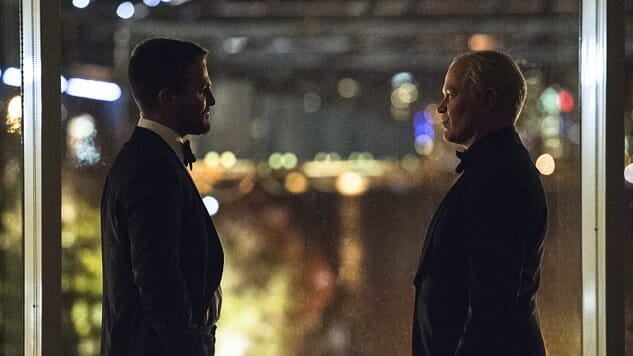
One gets the sense that “Brotherhood” is an episode that very well could have come earlier in Arrow’s run. If this hour is any indication, however, it’s that sometimes good things come to those who wait. Certainly, the mystery surrounding the death of Diggle’s brother, Andy, has been a long-simmering story point in the show’s ever-expanding mythology. It’s endured through Deathstroke’s rise and fall, Ra’s al-Ghul’s reign of terror as well as the death and resurrection of Malcolm Merlyn, Sara and Thea. And though much of the episode proves to be a showcase for David Ramsey, who beautifully rises to the occasion, it also serves as an effective exchange of ideas—the kind that, in many ways, can only exist in the latter years of an established show.
As we enter our story, Diggle reveals his brother’s dark, secret file to Oliver. It’s here that the divide between the two’s ideologies are put into stark contrast. Whereas the military-bred and logical Diggle believes the hard evidence put in front of him, Oliver—who has both seen and experienced his fair share of grey moral shadings—is more inclined to believe not all may be as it appears.
This dilemma reaches new heights when Team Arrow intervenes in another attack from Dahrk’s “ghost” army and Diggle discovers that one of the masked men is Andy, alive and well. Diggle’s feelings are…complicated, to say the least. The rest of Team Arrow is quick to point out the obvious positives— Diggle finally has his brother back. Naturally, Diggle doesn’t see things in quite the same light. In his mind, the Andy they’ve discovered is not the loving brother he once thought he knew. Rather, he’s a traitor who betrayed his moral obligations and abandoned his family for eight years, putting them through unimaginable mental anguish. Given the love Diggle has shown for his own wife and child, it’s understandable that such an action feels unforgivable to him.
Needless to say, when Team Arrow hatches a plan to “rescue” Andy, Diggle is not keen on the idea. Eventually, he comes around, as he’s grown to see Oliver as a true brother. Once the team has retrieved Andy and locked him up, Diggle finally gets his face-to-face. Not that it’s particularly productive considering Diggle grows more and more furious while Andy barely cracks an expression. The one big takeaway comes when Andy admits that everything in his dossier is true.
Meanwhile, Thea finds herself still struggling with her newly ingrained bloodlust. Whilst on a date with Oliver’s campaign manager, she ends up beating a man near to death after he aggressively hits on her. Seeking reprieve, Thea’s tempted by a visiting Malcolm who offers her the opportunity to take out a pedophile, thus ridding the streets of a horrible criminal and assuaging her rage for a time. During the episode’s final fight, however, Thea confronts Darhk who attempts to drain her lifeforce. In an unexpected twist, this backfires and ends up hurting Darhk and temporarily healing Thea. Realizing the opportunity, Thea invites Malcolm back into her life to help figure out a way that they can take advantage of this.
The show also finds time to explore Ray Palmer’s lingering feelings about being imprisoned, in addition to his subsequent reluctance to put the ATOM suit back on. Now freed from his prison cell, it’s great to once again get some nice one-on-one time between Felicity and Ray. Though their romantic liaison ultimately didn’t work out, the two maintain an effortless chemistry and Brandon Routh’s nervous energy is always a welcome source of comedy. In the end, Ray overcomes his fears and gets looped into the final battle.
Speaking of battles, it’s hard not to notice a major shift in how the fight scenes are filmed this time around. Rather than the traditional editing, the scenes are allowed to play out in longer sequences, with the camera dancing around to capture the actors as they move to different locations. This makes more sense when one learns that the episode was directed by noted stuntman, James Bamford. As last year’s John Wick so effectively demonstrated, stuntman-turned-directors like to linger on scenes as long as possible, as it allows the actual choreography to take front and center, as opposed to having the sequence chopped into little bits. Of course, this has its downsides, as staying on the actors reveals some of the more awkward moments of the choreography (there’s definitely one or two moments where you can tell they are not actually hitting their targets). In the long run, it’s a nice shakeup to the show’s aesthetic and here’s hoping it will not stand as a one-time experiment.
“Brotherhood” provides an amazing bounce back from the scattered mess that was last week’s installment. Between a more streamlined plot progression and some of the most dynamic battle scenes in the show’s history, it’s an hour that takes full advantage of every minute.